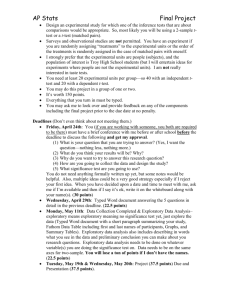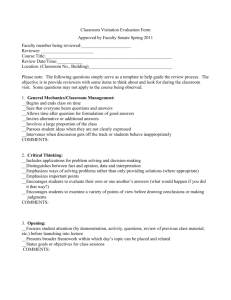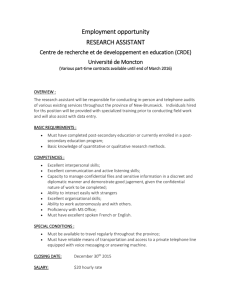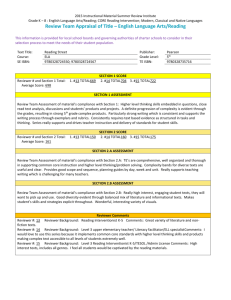To Journal Editorial Office BioMed Central Dear Editor: Thank you
advertisement
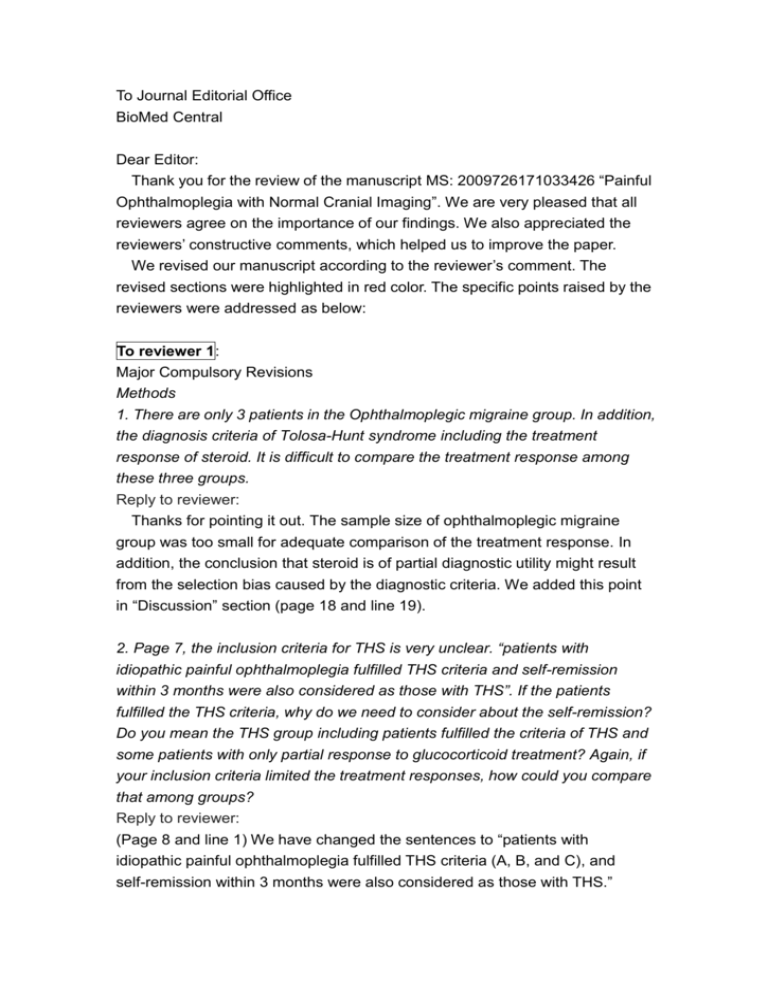
To Journal Editorial Office BioMed Central Dear Editor: Thank you for the review of the manuscript MS: 2009726171033426 “Painful Ophthalmoplegia with Normal Cranial Imaging”. We are very pleased that all reviewers agree on the importance of our findings. We also appreciated the reviewers’ constructive comments, which helped us to improve the paper. We revised our manuscript according to the reviewer’s comment. The revised sections were highlighted in red color. The specific points raised by the reviewers were addressed as below: To reviewer 1: Major Compulsory Revisions Methods 1. There are only 3 patients in the Ophthalmoplegic migraine group. In addition, the diagnosis criteria of Tolosa-Hunt syndrome including the treatment response of steroid. It is difficult to compare the treatment response among these three groups. Reply to reviewer: Thanks for pointing it out. The sample size of ophthalmoplegic migraine group was too small for adequate comparison of the treatment response. In addition, the conclusion that steroid is of partial diagnostic utility might result from the selection bias caused by the diagnostic criteria. We added this point in “Discussion” section (page 18 and line 19). 2. Page 7, the inclusion criteria for THS is very unclear. “patients with idiopathic painful ophthalmoplegia fulfilled THS criteria and self-remission within 3 months were also considered as those with THS”. If the patients fulfilled the THS criteria, why do we need to consider about the self-remission? Do you mean the THS group including patients fulfilled the criteria of THS and some patients with only partial response to glucocorticoid treatment? Again, if your inclusion criteria limited the treatment responses, how could you compare that among groups? Reply to reviewer: (Page 8 and line 1) We have changed the sentences to “patients with idiopathic painful ophthalmoplegia fulfilled THS criteria (A, B, and C), and self-remission within 3 months were also considered as those with THS.” In some patients with final diagnosis of THS, glucocorticoids treatment was not used initially due to the undetermined diagnosis at onset, and the evaluation of response to glucocorticoids was not possible. Since THS symptoms may resolve spontaneously when left untreated (JNNP 2001,71:577; Neurology 1961, 11:56; Cephalalgia 2013, 33:842), patients fulfilled THS criteria with self-remission within 3 months were also allocated as those with THS. 3. Page 8, line6, the OM criteria is wrong. The criteria should be “migraine like headache” followed by “ophthalmoplegia” within 4 days. The patients do not need have “recurrent migrainous headache”. Ophthalmoplegia is not only “ocular motor neuropathy”. Reply to reviewer: (Page 8 and line 7) Thank reviewer for careful check-up. We have revised the sentence to “Patients with migrainous headache accompanied or followed by ophthalmoplegia within 4 days in accordance with the IHS criteria for OM was allocated to the OM group”. 4. The patient numbers of idiopathic inflammatory Tolosa-Hunt syndrome (21 patients) were fewer than benign Tolosa-Hunt syndrome (25 patients). The diagnostic rate of MRI seems low. Do you have any explanation for this? Reply to reviewer: In this study, the ratio of benign and inflammatory groups was about half and half. The result is in accordance with the review by La Mantia et al. (Cephalalgia 2006; 26: 772–781); nearly half of the reported THS patients (41/85) manifested benign type. Given the nosography of benign THS has just been proposed for less than a decade, it is probable that such cases will continue to be diagnosed. The exact proportion of benign and inflammatory cases remains to be determined. We added this point in “Discussion” section (page 17 and line 1). 5. The diagnosis of OM in 1 patient with multiple recurrences and multiple cranial nerves involvement should be questionable. Actually, it is very rare in adult onset OM patients with multiple cranial nerve involvement. To my knowledge, there is no report now. It seems this patient had 3 attacks and each attack affecting multiple cranial nerves. Could you provide more detail to confirm the diagnosis of this patient? Reply to reviewer: Indeed, adult onset OM with multiple cranial nerve involvement is very rare. In this patient with multiple recurrences, migrainous headache with CN3 and CN4 neuropathy was observed in the first and second episodes. Isolated CN3 palsy was observed in the last episode. A complete biochemistry (including HbA1c, ESR, CRP, and autoimmune titer) and cranial MRI study performed in every OM episode did not show any finding. No other etiologies were identified after investigation. This patient has been followed up for more than four years without comorbid autoimmune or malignant diseases. Although multiple cranial nerve involvement in adult OM with is atypical and very rare, such a case has been reported before (British Journal of Ophthalmology, 1980, 64, 534-536). 6. Table 1 is very confusing and seems to have several problems. A. Ocular diabetic neuropathy group: 25 patients in this group, 2 of them with recurrences but only 26 episodes. It is impossible, right? B. The recurrence, N means patients numbers or attacks? C. The ptosis rate is very low in THS and OM group, even the CN3 is the most frequent involved cranial nerve. Do you have any explanation? Reply to reviewer: A. Thank reviewer for careful check-up. We corrected the errors in the table. Recurrent episodes were reported in 1 patient (4.0%) with ocular diabetic neuropathy and 2 patients (8.0%) with THS. B. N means the number of patients. C. The oculomotor neuropathy may develop with or without ptosis. In fact, we don’t know why the ptosis rate is lower in the THS and OM groups. The extreme low rate of ptosis in OM group might result from the bias of small sample size. Although the diabetes patients had higher ptosis rate than the THS patients, the difference between two groups was not significant (Chi-square test, p=o.173). The higher proportion of ptosis in the diabetes patients might have relation with the older onset age. Since the these patients were significantly older than other groups, age related degeneration of levator muscle and descent of the brow might also contribute to the ptosis formation (Postgrad Med J 2006;82:581). Minor Essential Revisions 1. In this study, except patients with OM, the other idiopathic painful ophthalmoplegia patients with normal MRI findings were separated into patients with and without DM. If the patients had DM, they will be grouped in ocular diabetic neuropathy, the rest of them grouped in benign THS. So, the difference of HbA1C in groups is because of the inclusion condition, no a surprising result. I suggested removing the discussion of HbA1C. Reply to reviewer: (page 16 and line 12) We removed the discussion of HbA1c as reviewer’s suggestion. To reviewer 2: Major Compulsory Revisions: 1. It is meaningful to discuss this group of patients. We advice the author to adjust the classification of the patients more objectively (such as with or without definitely diabetes mellitus) and discuss the controversy of the definition of ocular diabetic neuropathy, THS and OM. Ocular diabetic neuropathy was difficult to differentiate from Tolosa-Hunt syndrome (THS) with a history of diabetes or abnormality of glucose tolerance in patients with negative MRI findings. Although the ICHD-2 provided the diagnostic criteria for ocular diabetic neuropathy, THS and ophthalmoplegic migraine (OM), there are not methods that can definitely differentiate these definitions at the present technological stage. Reply to reviewer: Thank reviewer for the constructive comments. Figure 1 was added to illustrate the diagnostic process and the method of classification. In this study, the classification was based on the ICHD criteria and clinical specificity of each disease. Patients with definite diabetes (fasting plasma glucose ≥ 126 mg/dL or HbA1c ≥ 6.5 %) were designated as ocular diabetic neuropathy (Diabetes Care. 2011 ;34 Suppl 1:S11). In fact, it is difficult to differentiate ocular diabetic neuropathy from benign THS comorbid with diabetes or impaired glucose tolerance at this present technological stage. The limitation of the diagnostic criteria might lead to selection bias in the classification. We added this point in “Discussion” section (page 17 and line 19). 2. In the present study, the patients with ocular diabetic neuropathy were significantly older than other groups and had poor outcome than other group. Mean age of patients with diabetes mellitus may be more than 50 years old. Is diabetes mellitus a pathogenic factor or consequence for all of these? There was a fact that couldn’t be changed for retrospective study of the real situation about the patients group of THS with abnormality of glucose tolerance Reply to reviewer: (page 18 and line 7) Indeed, diabetic neuropathy can manifest before the diagnosis of DM (Diabetes care,2004,27:1458). It is possible that patients manifesting ophthalmoplegia with undiagnosed DM could be mistaken as those with THS. However, diabetic cranial neuropathies mainly occur in older individuals with a long duration of diabetes (Diabetes Res Clin Pract 1990,10:19); the mean reported duration of diabetes ranges from 8.5 to 16 years (Acta Diabetol 2009,46:23; Ophthalmologica 2008;222:225). An occult diagnosis of DM at this stage is very less likely. In addition, none of the THS or OM patients had a diagnosis of diabetes mellitus (fasting plasma glucose≥ 126 mg/dL or HbA1c ≥ 6.5 %) or impaired fasting glucose (fasting plasma glucose ≥ 100 mg/dL). Due to the limitation of a retrospective study, the data of impaired glucose tolerance (IGT), tested by oral glucose tolerance test, were incomplete in THS patients. Further prospective studies are warranted to clarify the relationship of benign THS and IGT. Minor Essential Revisions On page 9 line 7, “Chen, YL) with a on focus on the parasellar area and orbits. Both reviewers”, is it a expression question? Reply to reviewer: (page 9 and line 9)Thanks to reviewer for careful check-ups. We have corrected the error in the revised manuscript. Sincerely yours, Chih-Hsien Hung, MD; Kuo-Hsuan Chang, MD, PhD; Long-Sun Ro, MD, PhD
